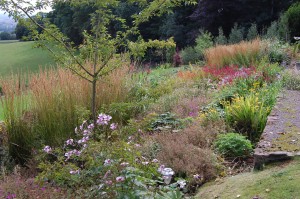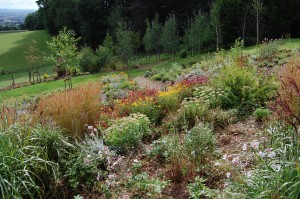
Most of this went in 3 years ago, some 2. Mostly filled out nicely. Its actually a north-facing slope but gets sun for most of the day. Grass is Calamagrostis ‘Karl Foerster’
Planting up a client’s garden the day before yesterday. The third winter I have done this particular one. Good design jobs go like this – it’s an illusion, partly fostered by TV design and ‘make-over’ programmes that you can go in and plant up, and before you can say “Bob’s yer uncle” the garden is “done”. No garden in ever “done”. And ideally, you and the client build up a relationship, you come back and see how it all turned out, you make suggestions, they ask your advice, you come back with more plants, and so it goes on, hopefully with an annual visit.
In this instance, a friend and colleague had done the levels and basic spatial stuff, and I came in to do the planting – three years ago. Quite a big site, so we all agree it would have been very foolish to plant up all at once. We agreed a section and I returned a few months later with the plants. The house has a spectacular view, as it is on the top of a hill with a steep drop below, and you can see the house when you drive into their property below. It needed to make an impact at first sight – so lots of big grasses for a long season of impact.
Most of my initial planting was a series of perennial combinations, each one designed to have a particular colour scheme but to have some interest at all seasons, along with willows and dogwoods for winter stem colour. Doing a planting scheme like this, where the beds have very rounded, flowing shapes is quite a challenge for working out quantities. In any case it is actually very difficult to match a plan with reality on the ground, unless you lay out a grid and relate that to a grid on the plan. The reality of soils and clients is that the ground never really matches the plan – slopes can create distortions, some patches of soil turn out to be unusable, setting out plants can often accumulates errors over large areas, clients shove in their own plants (annoying, but there is nothing you can do about this – I know Wolfgang Oehme would rip such plants out with his own hands while lecturing the client (following to be read in a heavy Saxon accent) “this is not your garden, this is my garden” but most of us are too nice to do this.
In this case I did not use a plan, in fact I very rarely do these days, I work out lists of plants, work out what proportions of one to another there should be, and then calculate on the basis of how much space they take up. All on an Excel spreadsheet. Its about a planting combinations, the overall effect, not a precise, ‘this looks nice next to this’ kind of approach. It saves a lot of time, and therefore the client’s money; in particular it makes a lot of sense for big jobs.
The big stress on site is worrying about whether you have brought enough plants, whether I have got the decimal place right in the calculations etc. But its usually ok. Surprisingly usually ok. But this first time we had far too many plants – so we just carried on planting another area.
Next year, you are back, because the client likes it, and the maintenance has worked out ok, so they want more. Hurray! So you do another area. But this is more difficult as there are young trees, and its even more difficult to work out quantities. This time around there aren’t enough plants, so the best thing to do is to leave some large gaps – thin planting looks awful so you might as well make the gaps look deliberate. Next summer I came to have a look and to estimate the size of the gaps so as to order more of the same to fill in, plus some others. This is serious guestimating but to my astonishment the other day when I came back with the plants, the quantity was all but perfect. None of this very unprofessional squeezing things in too tightly, or working out how to pad out big spaces between plants. Come on, admit it, every designer has been here.
This being the west of England the main issue long-term issue has turned out to be geranium management – Geranium x oxonianum management to be precise. This plant, parents from southern Europe (long mild wet winters) is tailor-made to cover gardens in the English south-west, and it seeds. Few complain – it flowers pinkly for a month in June and then again September to November. There are so many hybrids/varieties produced by nurserymen who obviously think “I can name this after my pretty niece and put it in the catalogue and boost my own ego into the bargain rather than throw it onto the compost heap”, everything from not-quite-white to the well-known ‘Claridge Druce’ screaming magenta-pink. The bottom line is this, the worst thing that can happen is that the garden just becomes geranium city. There are far worse fates.

Yes, this garden is on a slope – not quite enough to make mulch roll off, but being north-facing means that it is quite cool – and the good thing about that is that it doesn’t dry out too much.
Your responses/comments:
Thank you very much for your welcoming comments to my appearing on this blog. Its truly special to feel so appreciated by unknown folk living and gardening a long way from home, but united in a common passion.
I hope you’ll excuse me if I don’t have time to respond individually, but I will try to do a group response to posts, particularly if it is possible to draw together useful tips. On the subject of the author’s contact with their public – some years ago I helped a friend reshape her late grandfather’s garden in Cornwall, the late grandfather in question being William Golding, the Nobel Prize winning novelist (Lord of the Flies etc). The old man’s study had been left as it was. On his desk was a pile of cards with a message that read something like this: “William Golding thanks you kindly for your letter, but regrets that he cannot answer you personally, because if he did he would have no time to write any more books”.
Your comments on ‘Time for the CHOP’
Frank Hyman ‘s comments “I’ve taken wacking perennials and grasses back with either manual hedge clippers or a cordless hedge clipper and starting at the top, taking a few inches off as I go down. That way short strips of stem and foliage drop to the ground and form a mulch around the plant. “ – is kind of what I have been trying to do, I think it works but there is a knack to using the tools, which you just have to learn, which can take time.
professorroush is maybe mystified by Eupatoriadelphus fistulosus. OK Eupatorium have recently suffered a reclassification, they were pretty confused anyway I reckon. Check out the USDA website for plenty of detail on what’s what and a very good source of info on natives generally – http://plants.usda.gov
I like the contrarian nihilism of Liz ‘s “My favorite way to get rid of tons of debris is throw it in a big hole”. I remember reading some critique of organic gardening a few years ago, where the author was suggesting that compost heap building was a pointless waste of time and why not bury it all, and grow on top? Actually that is just what traditional (i.e. my late father’s generation) used to do on their veg plots, specifically digging a trench two spits deep, chucking in all the debris, backfilling with soil and then growing beans on top.
Laura Mathews says that “I constantly get stuck between my friends who garden with biodiversity foremost in their minds and horticulturalist friends who worry about the spreading of disease that is possible when you leave debris to over-winter.” – to be honest I think the disease worry is a bit of a hangover from a previous generation of gardeners, it may be applicable for crop plants, e.g. to control peach leaf curl, but I don’t think its that relevant for ornamental perennials.

